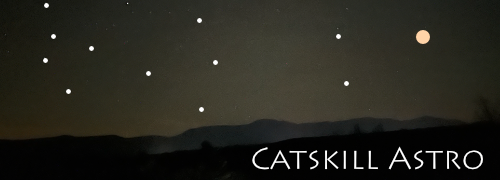Arp’s Peculiar Galaxies
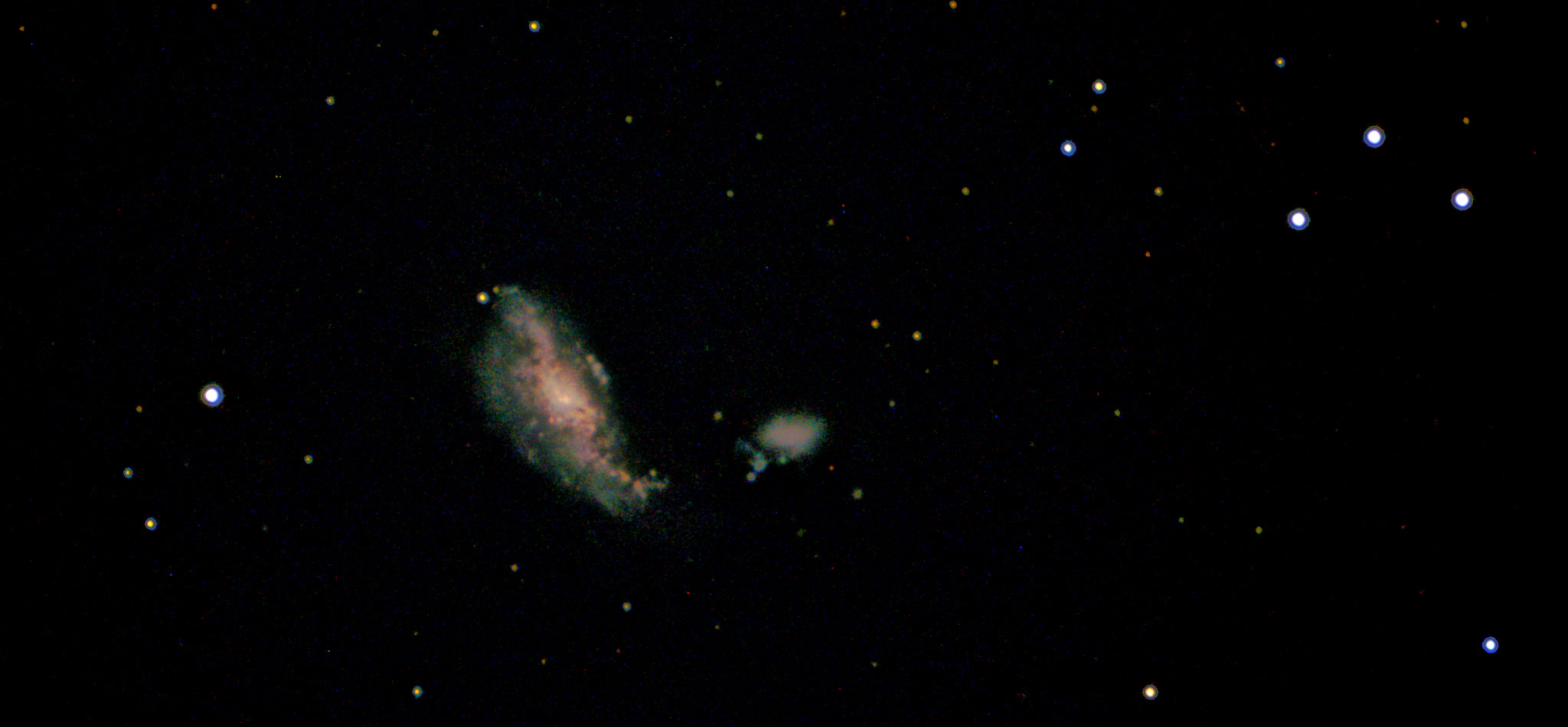
Page 3 of 16
Arp observations 21-30 of 155 total to date.
| Thumbnail | Title/link | Arp Category | Date Observed | Observer Description |
|---|---|---|---|---|
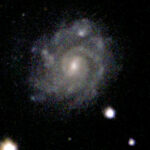 |
Arp 38 / NGC 6412 | Spiral galaxies with low surface brightness companion on arms | 2024-06-12 22:59:00 | This was captured almost due north early in what is nearly the shortest evening of the year, with a 35% crescent moon in the west. This is a lovely, seemingly "normal" spiral galaxy with a slight bar. Arp categorized it as having a "low surface brightness companion on arms" which, frankly, I found challenging. Note Arp designates "companion", singular. Is Arp suggesting the glowing, slightly nebulous spot at the top (N) end of the disk is a dwarf "companion" galaxy? His remarks call out, "Small ring in arm on N side," so it seems likely. Like many "nebulae" in this part of the sky, this was discovered by William Herschel in 1797. I find the Herschel family's story inspiring and like to comment in these notes when I discover it's the case. What an amazing brother/sister/son combo they were! |
 |
Arp 41 / NGC 1232 and 1232A | Spiral galaxies with low surface brightness companion on arms | 2024-12-25 22:29:00 | Eridanus is pretty far south, and Arp 41 reached a maximum height of 28° elevation on the night I observed it. It barely cleared my southern horizon post-meridian, but the low elevation made it vulnerable to clouds, which obscured it after only 5m of integration. Amazingly, it was enough to show the key features which merited Arp 41's inclusion in Atlas, specifically "a low surface brightness companion on one of its arms". This is the grey smudge on the bottom right. While the bottom arm would require longer integration to render fully, there is a hint of it even in this brief capture. |
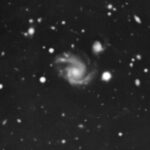 |
Arp 42 – NGC 5829 with IC 4526 | Spiral galaxies with low surface brightness companion on arms | 2025-07-22 23:25:00 | Arp clearly felt these two galaxies are interacting. He left, for him, a verbose set of remarks: "Faint bifurcated arm to companion, one faint arm on companion coiled same direction as parent". Why he felt it was important that the companion was coiled in the same direction is unstated. And, of course, reading this before observing, a key objective for me was to make sure my observation captured the "faint arm" on the companion. That turned out to be very challenging. The arm is truly faint, and I saw NOTHING until about 50 minutes into the observation, which is an enormous amount of integration given the sensitivity of the Apollo M-mini camera. In this presentaiton you're seeing the image after additional processing, so it may not seem so obscure. I, of course, was planning to continue collecting lights as long as necessary, but clouds put an end to that dream. |
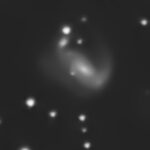 |
Arp 46 / UGC 12265 | Spiral galaxies with low surface brightness companion on arms | 2024-10-26 21:33:00 | These are truly obscure galaxies. As far as I can tell, Arp 46 is alternatively listed only as UGC 12265, which is from the Upsala Catalog published in 1973. I believe there are TWO "low surface brightness companions" here, and possibly 3, best seen in the featured image which has been enlarged about 3x and rotated so N is up. The first is the small, slightly elongated, bright spot (with galaxy-like halo) to the NNW (top left) of the galactic disk (next to another bright circle, which appears to be a star within the Milky Way). The second is the small dot, with an even fainter halo, at the end of the long, looping tail that starts at the SE end (bottom right) of the central disk and loops all the way up the image so it's due north of the galactic center. Put another way, it's the faint dot at a roughly 45° angle up and to the right of the star in the Milky Way mentioned earlier. By itself, neither my image nor Arp's conclusively demonstrates it's a second companion. The third companion, imo, is at the base of the long looping tail where it connects to the main galaxy. It does look like a small galaxy attached at right angles to the center spiral, possibly which might explain how such a long trail was drawn-out to the far end of the bigger galaxy. |
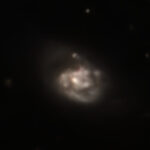 |
Arp 49 / NGC 5665 | Spiral galaxies with small high surface brightness companions on arms | 2024-06-07 22:22:00 | Arp classifies this as having "small high surface brightness companions on arms.". He notes, "Appearance of wake from stellar object in E arm." and the wake is pretty evident in the image extending towards the upper left corner (Note, east on Arp's images is counter-clockwise from north, and we can see from the comparison image that the white divot is right). Both considerations suggest the companion is the bright dot on the end of the arm that extends upwards in the image. That said, I don't feel this is the most compelling "high surface brightness companion" I've seen. This was the first observation during a brief, clear window on a mostly cloudy evening during a new moon. Significantly, I was able to complete this observation at 10:22 PM on an evening when Astronomical Dusk didn't hit until 10:43. Fortunately its location in Bootes to the SSW was sufficiently far from the residual sky-glow in the NW. |
 |
Arp 66 / UGC 10396 | Spiral galaxies with small high surface brightness companions on arms | 2025-08-27 22:44:00 | Not much to say about this one other than that, indeed, there is small, High brightness companion: presumably the small bright oval hanging at the end of the top arm. |
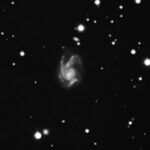 |
Arp 69 – NGC 5579 | Spiral galaxies with small high surface brightness companions on arms | 2025-07-21 23:28:00 | Arp's remarks are simply, "Three-armed spiral." The classification identifies small, high surface brightness companion on arms. That could be the small spiral you see towards the top of the comparison images. It's the only obvious candidate, for a distinct companion, but it could also be any of several bright knots attached to NGC 5579 itself. |
 |
Arp 70 / PGC 5085 and 212740 | Spiral galaxies with small high surface brightness companions on arms | 2025-08-28 01:05:00 | The Arp image shows faint dust lanes "nearly" connecting the larger galaxy (PGC 5085 or Arp 70b) and the smaller one (Arp 70a or PGC 212740). Frankly I struggled to reproduce the dust lanes, in part because my camera was rendering not a wisp of dust, but an extended arm connecting the two galaxies. It's clearer in the positive image. This is another case where a modern CMOS camera on an 8" telescope delivers "deeper" imagery than the best telescope in the world from 1966. |
 |
Arp 71 / NGC 6045 | Spiral galaxies with small high surface brightness companions on arms | 2024-11-03 18:45:00 | On the first night of Standard Time observing, I was anxious to capture a few Arp Galaxies in Hercules, which are setting early. Arp 71 has been on my list for a while, so it was first up as soon as I achieved PA. Elevation was below 20° from the start, which makes the target vulnerable to satellite trails. If you look at the comparison shot from the Arp Atlas, developed into a positive (left hand image, believe it or not), the 200" Palomar telescope struggled with this object, so it's no wonder that my 8" Celestron did as well. NGC 6045 might be edge on, but it appears more likely to be an extreme barred spiral (SBc) where the surrounding envelope is simply too dim to show up in this image, and all we can see is the galactic center. Also suprisingly, the "high surface brightness companion" is more obvious in my image than Arp's... a dwarf galaxy hanging off the top of the bar. |
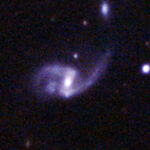 |
Arp 72 / NGC 5996-5994 | Spiral galaxies with small high surface brightness companions on arms | 2024-06-13 00:49:00 | This observation principally shows two galaxies exchanging mass via a long tidal tail: the larger, NGC 5996 connecting to NGC 5994. 5996 is a barred spiral galaxy, with its bar pointing to 5994. Arp's remarks record, "Faint material from arm to and around comp." 5994 is the only "bright" object this fits. Presumably the two galaxies passed by each other too quickly for 5996 to fully capture 5994. Instead, the interaction peeled off and elongated the eastern arm of 5996 and created the tidal exchange with 5994. The second image in the gallery is an inverted monochrome version of my capture. While not as detailed as Arp's own, it clearly confirms Arp's remarks. |
